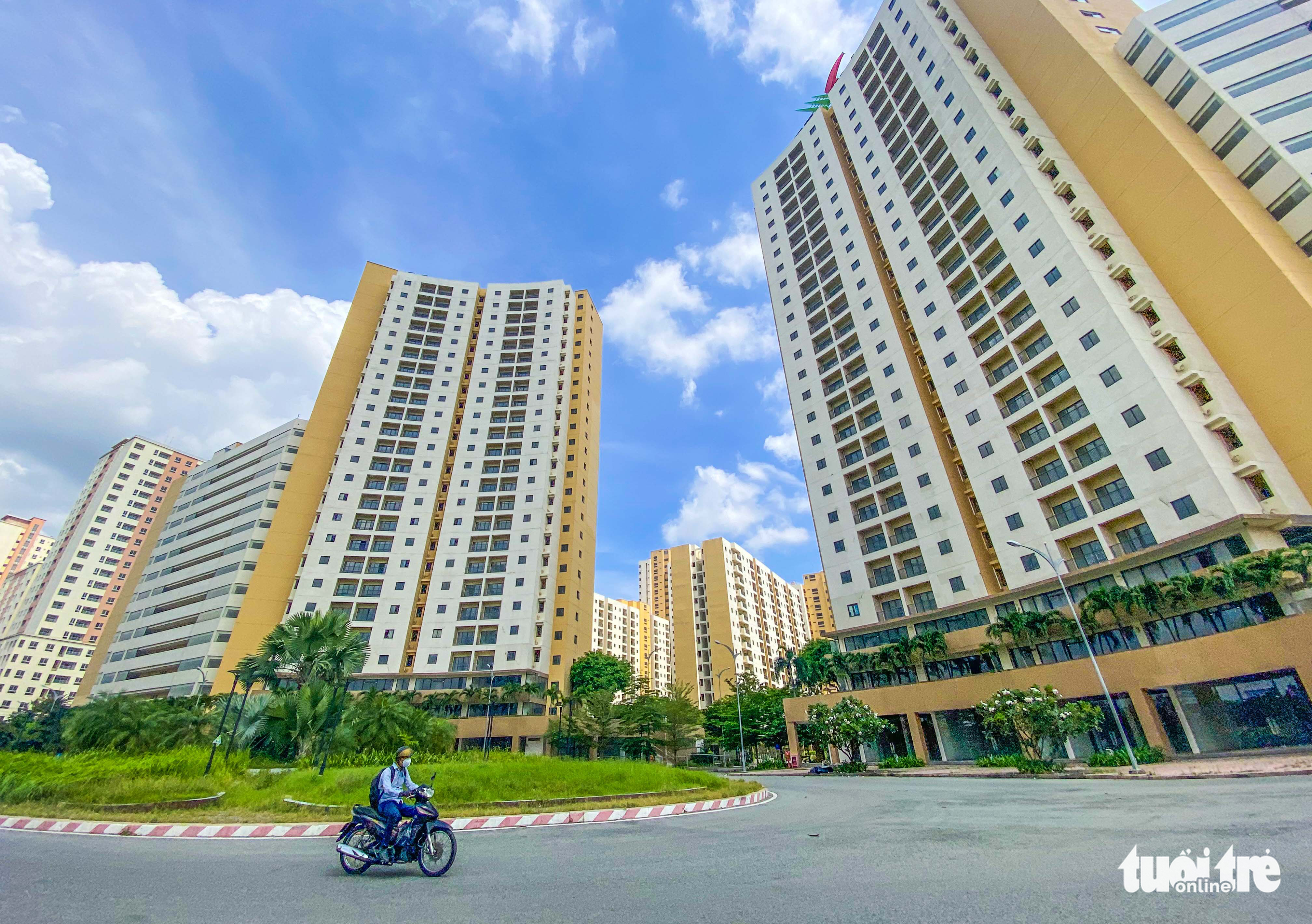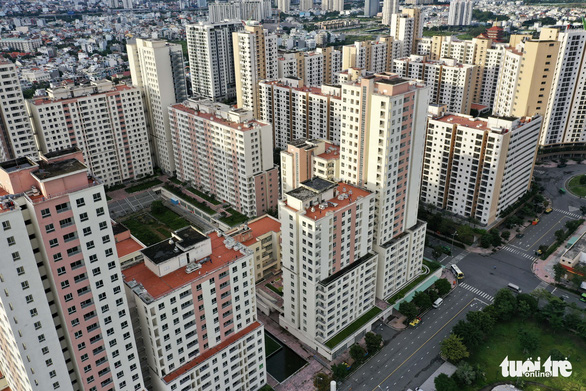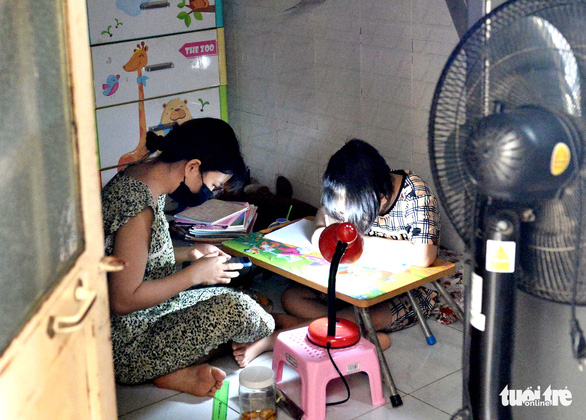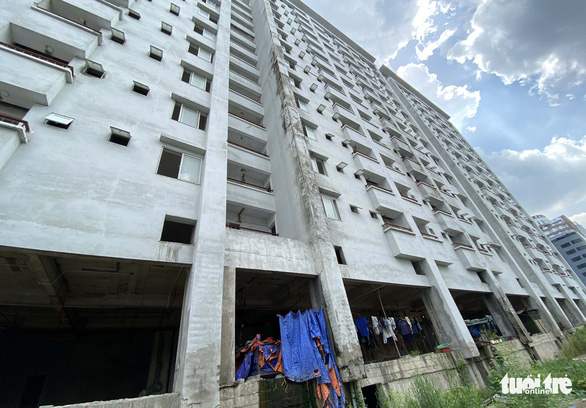Thousands of apartments and land lots for the resettlement of residents in Hanoi and Ho Chi Minh City have been left deserted for years, causing huge waste.
While many laborers are in dire need of accommodations, solutions to these abandoned resettlement apartments and the resettlement in the future to prevent similar cases are needed.
Abandonment and untidiness
According to the Hanoi Department of Construction, the capital city is now home to nearly 18,000 resettlement apartments.
Most of them have been sold and allocated for projects. Only over 400 units remain unused.
However, in reality, thousands of these apartments are presently empty.
Some projects with hundreds of apartments each are complete but their wastewater treatment and fire prevention and control systems have yet to be approved.
Most of these projects are now degrading and facing a shortage of facilities, such as playgrounds for children, sport facilities, and parks.
|
|
| More than 3,700 resettlement apartments in Thu Duc City under Ho Chi Minh City are going to be converted into commercial apartments to recover capital and offer more accommodations to local residents. Photo: Tu Trung / Tuoi Tre |
As a case in point, despite breaking ground over 10 years ago, the N01-D17 resettlement apartment project at the intersection of Tran Thai Tong and Duy Tan Streets in Dich Vong Hau Ward, Cau Giay District, Hanoi is overgrown with weeds, while its front is still surrounded with corrugated iron sheets.
Apartments there were planned to be allocated to households whose land was taken back for the Nguyen Van Huyen Street extension project.
The resettlement project was designed to include four 15-story buildings with each apartment measuring 50 to nearly 90 square meters in area.
Le Van Bich, 62, living on Duy Tan Street in Dich Vong Hau Ward, said since the project has been left unused for many years, surrounding residents sometimes dumpe waste at the site.
The N3-N4-N5 resettlement apartment project in the Sai Dong New Urban Area in Long Bien District’s Phuc Dong Ward faces the same fate.
Three blocks with over 150 apartments have been deserted for many years.
Local residents made use of the land at the back of the project to grow vegetables.
Meanwhile, many other parts of the site have deteriorated seriously.
“The land at the back was overgrown with weeds so we tidied it and grew vegetables now," said Nguyen Thi Hang, a 42-year-old resident in the Sai Dong New Urban Area.
“We expect the city to put the project into operation so that we will not have to watch over strangers who often gather there late at night."
Another project, situated on Tran Phu Street in Hoang Mai District, which is a prime site, has also lain dormant for many years.
The project with three resettlement apartment buildings already became a destination for drug addicts.
Several hundreds of meters from this site, two resettlement projects on Khuyen Luong Street and another with more than 10 floors in alley No. 156 of Tam Trinh Street in Yen So Ward, Hoang Mai District have not welcomed residents for many years.
Auctions remain on paper
A representative of the Hanoi Department of Construction said residents had not moved into resettlement apartments as some had filed complaints, while others decided to receive money rather than a flat.
In some projects, the Hanoi People’s Committee has yet to issue decisions to sell resettlement apartments.
“We will continue urging investors to put projects into operation soon," the official added.
“As for over 200 apartments involved in violations, the municipal Department of Construction will coordinate with Hanoi Housing Management and Development Co. Ltd. and the authorities of districts to take back the land used for improper purposes and handle such violations.”
Similarly, in Ho Chi Minh City, there are also thousands of abandoned resettlement apartments.
For example, many blocks in the Vinh Loc B relocation area in Binh Chanh District are currently degraded.
According to statistics from the Ho Chi Minh City Department of Construction, the city now has nearly 11,700 resettlement apartments and land lots.
Of the total, some 4,000 apartments and land lots are allocated to districts, over 2,500 others are for backup, while procedures to put nearly 5,000 apartments and land lots up for auction are in process.
Pham Dang Ho, head of the Housing and Real Estate Market Development Division under the municipal Department of Construction, said most of the resettlement apartments and land lots in the city put up for auction are in suburban areas, which does not meet the demand of dwellers.
Some apartments were built a long time ago, while certain resettlement projects have a small number of units with scattered locations, so it is hard to designate these apartments for residents affected by the same project.
However, the jurisdiction over the auction of resettlement apartments remains unclear.
Earlier, the Ho Chi Minh City People’s Council issued a resolution empowering the chairperson of the municipal People’s Committee to take charge of the auction of houses as regulated in Government Decree 167 on the rearrangement and handling of public assets.
Individuals and organizations with the jurisdiction to auction resettlement apartments remain unknown. Therefore, the municipal People’s Committee will report the issue to the People’s Council so that the latter can work out solutions.
Regarding the proposal to convert resettlement apartments into social housing, Ho said if relocated households have no accommodations and do not have enough money to buy such units, they will be allowed to purchase or lease social apartments, under the prevailing regulations.
The conversion of resettlement apartments into affordable housing is in line with the law, Ho added.
However, the price of low-cost houses does not include land use fees.
Meanwhile, resettlement apartments may be funded by the state budget, or converted from commercial flats developed by private firms and affordable units built by state or private companies.
If their sale price does not include land use fees, the capital sourced from the city’s budget cannot be sufficiently recouped.
|
|
| A narrow rented room in District 8, Ho Chi Minh City. Photo: T.Trung / Tuoi Tre |
As a result, it is more reasonable to auction resettlement apartments to fund other resettlement or social housing projects.
Reviewing resettlement apartment projects
In May this year, the Ministry of Construction wrote to the People’s Committees of cities and provinces, asking them to report resettlement apartment projects within their precincts, the number of resettlement apartments which have been developed, and the allocation and management of such units.
In addition, these localities were requested to report the number of unused resettlement apartments and those which were proposed to be converted into affordable or commercial houses and other purposes.
They should also clarify difficulties and obstacles in the management and use of resettlement apartments and put forward solutions.
Proposals
Regarding a plan to develop land banks for resettlement apartment projects in the future, Pham Dang Ho from the Ho Chi Minh City Department of Construction said the state should build low-cost houses to meet the demand of households that are affected by projects but cannot afford new accommodations.
Those who can afford new houses will be offered compensation so that they can take the initiative to stabilize their lives.
The state can also reduce the use of the budget for resettlement housing projects.
If the land fund is exhausted, the state can acquire land lots from investors.
Meanwhile, many experts said that besides apartments which will be put up for auction and those whose use purposes will be converted, backup houses should be leased to generate revenue.
Dr. Dao Ngoc Nghiem, vice-chairman of the Vietnam Urban Planning and Development Association, said infrastructure development plans must include resettlement projects.
However, resettlement apartments should be better than residents’ previous houses.
Moreover, the technical and social infrastructure of resettlement projects must also be a part of development. In many projects, there are no playgrounds and kindergartens.
According to Nghiem, abandoned apartments should be leased for a short term to earn revenue.
“Lease contracts should include the term that these apartments will be returned if required. Unused apartments can be sold to the needy as housing remains an urgent demand of many people,” Nghiem suggested.
Meanwhile, former Deputy Minister of Natural Resources and Environment Dang Hung Vo said many resettlement apartments were of poor quality and deteriorated quickly, so many would-be residents refused to move in.
These apartments are also ineligible to be converted into commercial housing.
To deal with the abandonment of resettlement apartments, they should be leased to prevent wastefulness.
However, the leasing must be appropriate to prevent disputes and lawsuits.
Unused resettlement apartments should be converted into budget houses due to the current severe shortage of affordable units.
In the long term, resettlement flats must be improved to instill confidence in residents.
“Resettlement and low-priced houses can be merged into a segment," Vo noted.
|
|
| The deserted N01-D17 resettlement apartment project in Dich Vong Hau Ward, Cau Giay District, Hanoi. Photo: Q.The / Tuoi Tre |
“However, it is not advised to focus on reducing the quality of projects to lower their prices."
According to Dr. Dao Ngoc Nghiem, many projects in Hanoi which are 80-90 percent complete have been suspended due to the shortage of capital, while some others have been finished but their fire prevention and control and wastewater treatment systems have yet to be approved.
Therefore, these projects should be completed before being sold, leased or converted into social houses.
Most resettlement projects are developed in prime sites.
The acceleration of the execution of these projects will meet the housing demand, ensure the urban landscapes, properly use land resources, and avoid the wastefulness of the state capital poured into such projects.
Nghiem added that planners and architects had yet to come up with feasible resettlement models to meet diversified demands.
Residents will not agree to move to suburban districts if their land is in inner areas, resulting in the abandonment of resettlement apartments.
It was proposed that new urban areas should include resettlement and social apartments, but enterprises have opposed the proposition.
Resettlement projects are not only accommodations but also a foundation for urban development and economic restructuring.
Dr. Nguyen Thi Anh, deputy head of the Law Faculty of the University of Economics Ho Chi Minh City’s College of Economics, Law, and Government, attributed the abandonment of resettlement apartments to the state’s and investors’ failure to survey the opinions and demands of residents whose land will be taken back.
They just tell displaced residents of the tentative relocation plans.
The resettlement is done in a top-down manner, when it should be bottom-up
Policymakers should listen to the opinions and demands of residents so that they can secure consensus on their decisions.
Therefore, surveys are needed to know residents’ expectations about resettlement apartments and living conditions, incomes, family members, jobs, and their expected resettlement forms. If so, resettlement policies will match residents’ demands.
Ensuring livelihood for residents whose land is reclaimed
At a recent conference to make comments on special policies for Ho Chi Minh City, economist Phan Chanh Duong, former deputy general director of Tan Thuan Export Processing Zone Joint Venture Company, retold a story about the compensation and relocation of residents to develop the export processing zone.
Policymakers can learn from the story to set out the compensation and change the arrangement and allocation of resettlement areas for residents affected by projects.
Duong related that while developing the export processing zone, the land in low-lying areas was transferred at VND6,000 (US$0.26) per square meter, while the price was VND12,000 ($0.51) per square meter if the land was leveled and in higher locations.
At the time, if the export processing zone was successful, the land price might increase 10 times.
Meanwhile, poor residents without appropriate compensation would find it hard to stabilize their lives.
Therefore, the city decided to give households without land use right certificates VND11,500 ($0.49) per square meter in compensation and those with land use right certificates VND13,000 ($0.56) per square meter.
As the compensation was double the land selling price, residents accepted and used it to buy other land lots.
On the other hand, the project management board also had a plan to build the Tan My resettlement area adjacent to the Phu My Hung New Urban Area.
According to the board, once Nguyen Van Linh Boulevard and the urban area were developed, the entire region would turn itself from a marsh into a spacious and modern urban landscape.
Residents could see and benefit from the state’s infrastructure development.
Duong said while conducting the Tan Thuan Export Processing Zone project, he understood that land was the production and living foundation of the local people.
“It is probably not good for residents who have gotten used to living in land-attached makeshift houses if we send them to spacious apartments," he said.
"They may file lawsuits.”
They have lived on land for generations and the land has become an indispensable part of their lives.
Therefore, when developing the South Saigon area, Duong did not plan to compensate once but came up with an idea to establish a joint stock company which land owners could contribute to and earn profit from all their life.
However, the idea was not given the green light.
Like us on Facebook or follow us on Twitter to get the latest news about Vietnam!















































